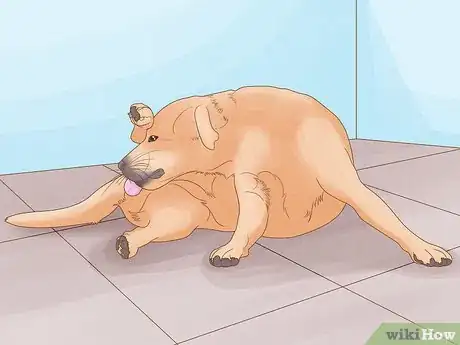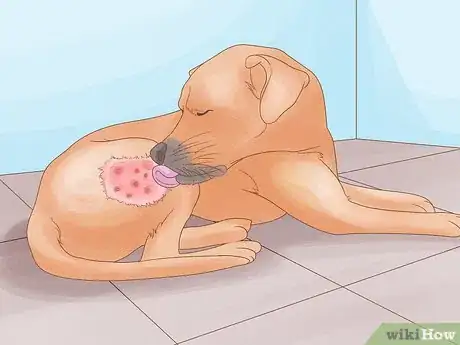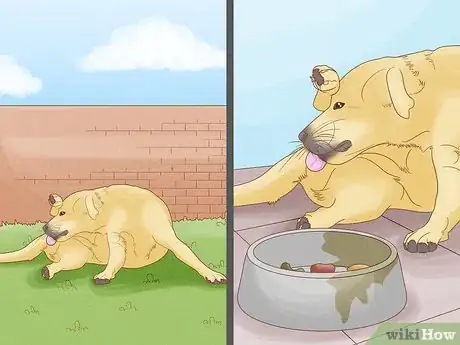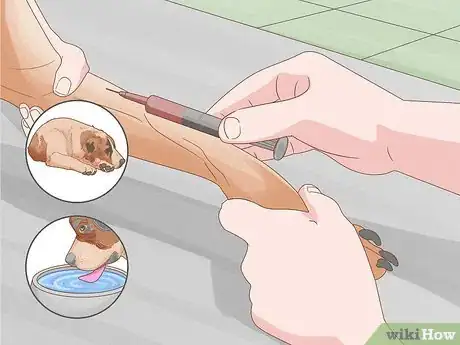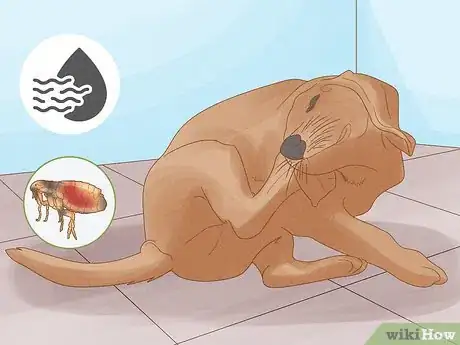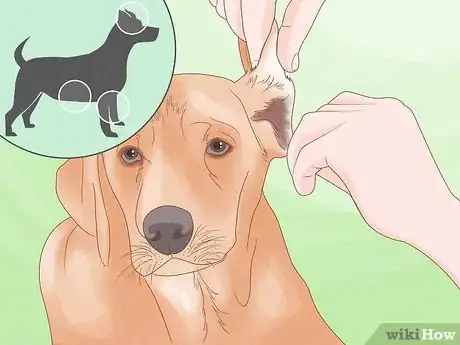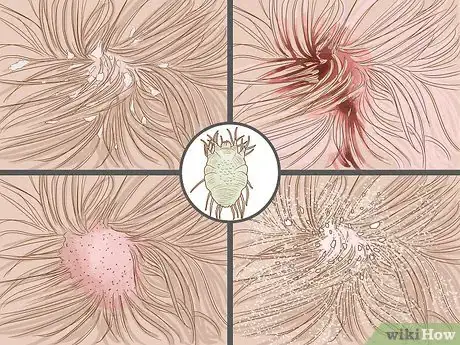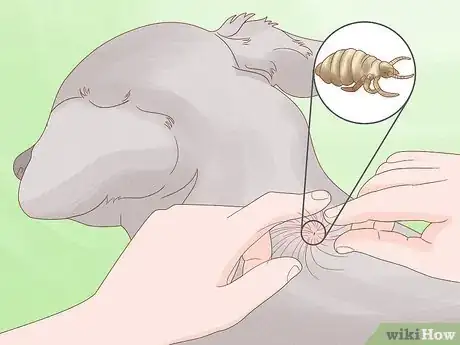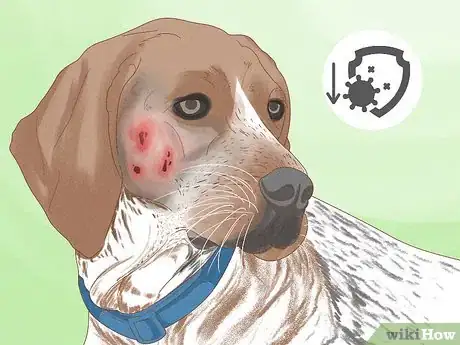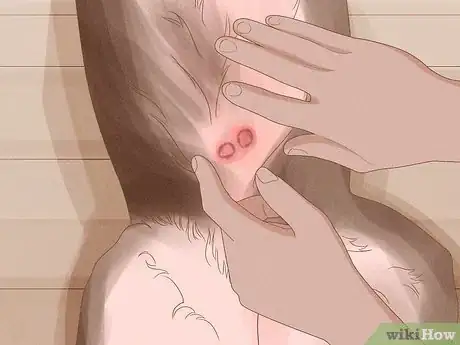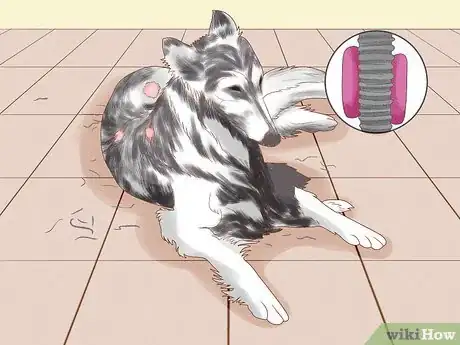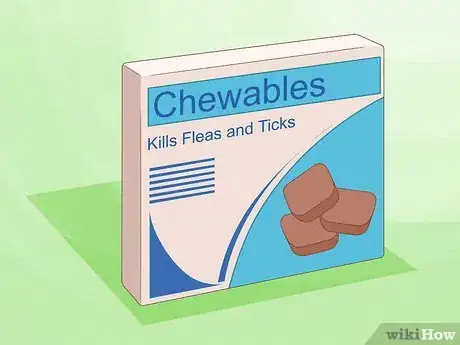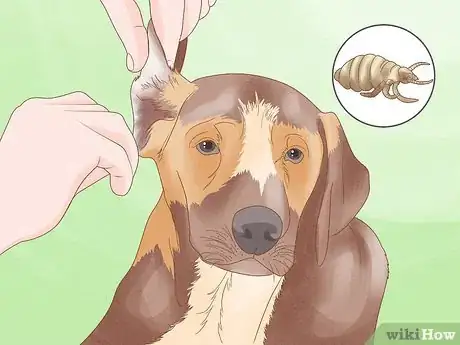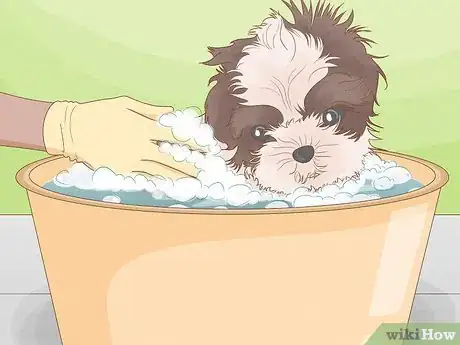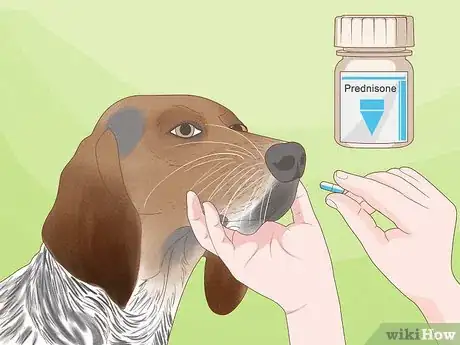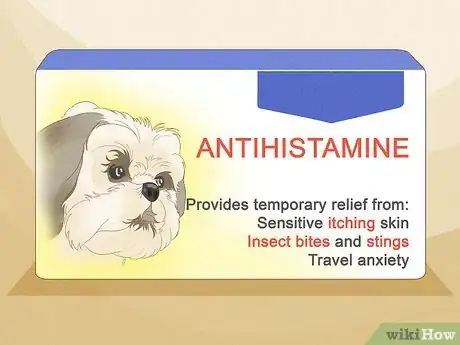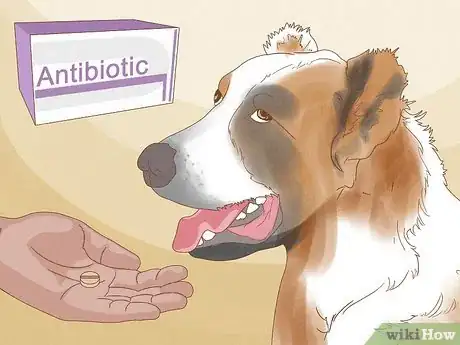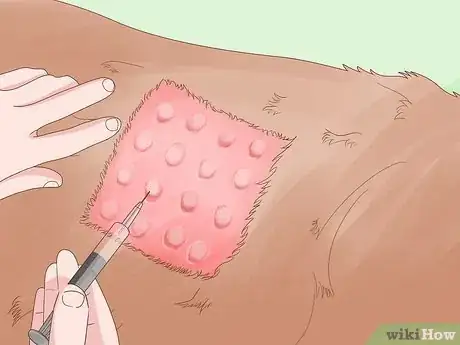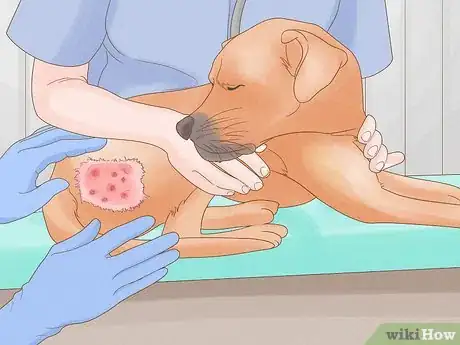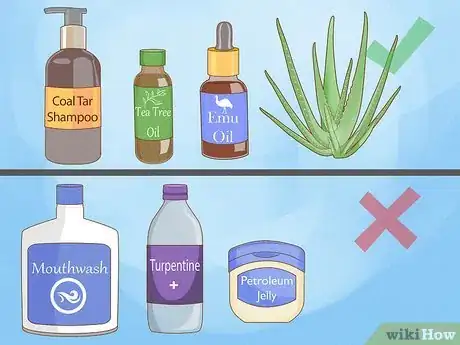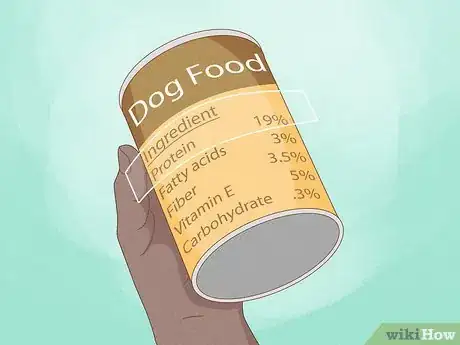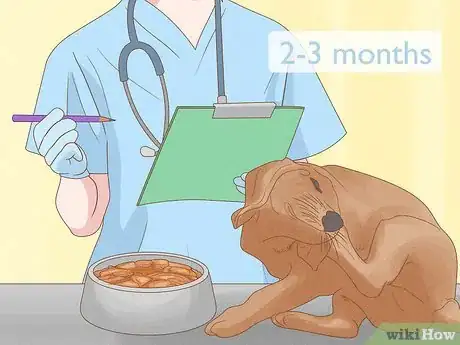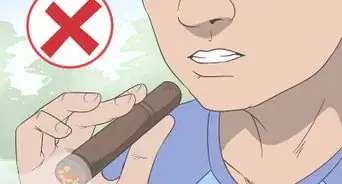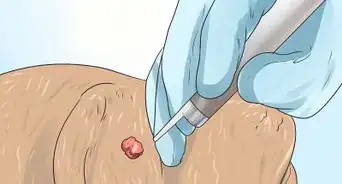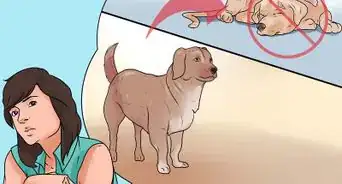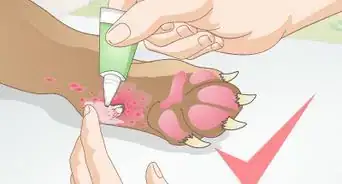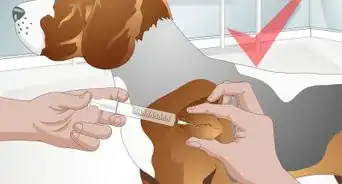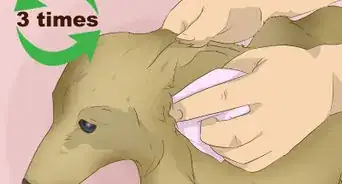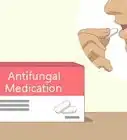This article was co-authored by Stephanie Abrams, DVM, MS, DACVD. Dr. Stephanie Abrams is a Board Certified Veterinary Dermatologist with over eight years of veterinary experience. She specializes in treating skin conditions in cats and dogs. Dr. Abrams earned a BA from Skidmore College and a DVM from Ross University School of Veterinary Medicine. After earning her DVM, she completed an internship at Tufts Veterinary Emergency Treatment & Specialties, followed by a residency in Dermatology at the Ohio State University School of Veterinary Medicine.
There are 18 references cited in this article, which can be found at the bottom of the page.
wikiHow marks an article as reader-approved once it receives enough positive feedback. This article received 18 testimonials and 100% of readers who voted found it helpful, earning it our reader-approved status.
This article has been viewed 1,471,784 times.
Similar to people, allergies in dogs are managed and not cured. The dog’s body is hypersensitive to something and the reaction to that hypersensitivity is itching. Dogs can be allergic to their food, flea bites, grass and pollen in their environment, or direct contact with certain compounds like laundry soap or hay. The first step is to diagnose your dog's itching, scratching and chewing as a skin allergy problem. The challenge for you and your veterinarian is figuring out the causes and finding an effective treatment.
Steps
Monitoring Your Dog’s Itchiness
-
1Pay attention to which parts of your dog's body are itchy. Is there a certain area on the body that is itchier than others? Does your pet lick his feet, under his tail or along his belly? Discovering the underlying condition to the itchiness is what will give you the best treatment for the issue.
- The most common areas of irritation for allergic dogs are around the back and tail, the abdomen, and the legs and paws.
-
2Look for hot spots on your dog’s skin. It can be common that your dog’s itching is so severe that he chews his skin to the point of creating a “hot spot”. This skin lesion can develop overnight and can get very large very quickly. The skin is pink, moist, hot and painful. You may even see sticky material oozing from the wound created. These are infected open wounds and need veterinary intervention to give your pet relief.
- Chronic cases of itching might result in the thickening and roughening of the skin so that it looks like elephant hide.
- Hot spots are often the symptom of allergies to fleas, foods, grass, mold or other environmental substances. There may be more complicated underlying conditions such as low thyroid (hypothyroidism) levels or Cushing’s disease (hyperadrenocorticism). Secondary bacterial and yeast (malassezia) infections are not uncommon and will require specially tailored treatment.[1]
Advertisement -
3Consider the timing. There might be a particular time of year that your dog is itchier. Perhaps he is itchy after being on the lawn or after eating a certain food. By noticing patterns, you will help to narrow the focus of your pet’s treatment to help with the itching.[2]
- Dogs are usually itchy due to an underlying allergy. If you find that their itching is only seasonal, meaning they're only itchy during certain seasons of the year, then that fits within environmental allergy. However, if your dog is itchy all year round, then that means it could be food or environmental allergies.
-
4Check on your dog’s overall health. If your dog has a really strong body odor, seems excessively thirsty or does not seem as lively as usual, you should take your pet to the veterinarian. Your veterinarian will need to do blood tests and evaluate swabs from the skin surface to get more information to help define appropriate treatment.
-
5Take notes when you notice the itching. Whenever you notice your dog itching, write down the circumstances, including where your dog has been, what he’s been eating and what part of his body is itchy. This will be extremely useful for your veterinarian, who will rely on this information to narrow down the possible causes for your pet’s itching and skin lesions.
Checking for Parasites
-
1Check for fleas. The most common cause of itchy skin is fleas. They are most active in warm, humid weather (35°C or 95°F). You may see the fleas on your dog, or you may just notice your dog biting or scratching their skin. Fleas are very quick and can jump very high, so you will need to be fast to spot them. Fleas are most likely to be found in the armpit and groin area and are dark (almost black) with flat bodies.[3]
- Check your dog's ears for signs of scratching, redness, blood, or dirt. See if their belly, groin, or the base of their tail has red bumps.
- One way to check for fleas is to stand your dog over a white surface, such as paper towels or pieces of paper, then comb their coat. Flea feces will fall out when you comb the dog and it will be more visible on the white paper.
-
2Check for sarcoptic mange. Sarcoptic mange (Sarcoptes scabiei) is a parasitic mite infestation. Mites will usually live in areas of the skin that do not have hair such as the ear flaps, elbows or stomach. The dog may have red, scaly skin in these areas.[4] Sarcoptic mange can cause significant skin lesions and distress for the dog because the mite causes severe itching.[5]
- Sarcoptic mange is contagious and can be transmitted to people and other dogs very easily.
- Your veterinarian can diagnose sarcoptic mange by collecting skin scrapings from your dog.
-
3Check for cheyletiellosis, or walking dandruff. This is caused by the Cheyletiella mite that feeds on the top layer of skin. In addition to excessive scratching, the dog may have scaling on the skin, hair loss, dandruff, lesions on their back.[6]
- It is sometimes called "walking dandruff" because the mite pushes up scales of skin as it travels, making it appear as though the scales are moving.
- You might be able to see the mite, which is yellow.
-
4Check for lice. Dog lice is different from human lice, so don't worry about infecting each other. Lice survive on either your dog's skin debris or their blood, depending on the species. You should be able to spot adult lice on your dog — they are yellow or tan and about the size of a sesame seed. They can sometimes be mistaken for dandruff, but will not fall off the dog if you shake the hair.[7]
- Other signs of lice include hair loss (especially around the neck, ears, shoulder, groin, and anus); a rough, dry, or matted coat; small wounds or infections; tapeworms or other parasites that can be spread by lice; and even anemia in severe cases or in small dogs.
-
5Check for demodectic mange. Demodectic (red mange) is caused by small mites found naturally on most dogs. These mites do not generally cause skin problems unless the dog’s immune system is compromised. Demodex is most commonly seen in puppies, because their immune systems are still developing. This mange is most noticeable around the eyes and mouth. It can be diagnosed by your veterinarian collecting skin scrapings from your dog.[8]
- Demodectic mange is not very contagious and people cannot contract it. It is generally passed on to nursing puppies by the mother.[9]
- A predisposition for this skin problem may be inherited. It is not uncommon for the puppies to have Demodex if their parents also had Demodex at some point in their lives.[10]
-
6Check for ringworm. Ringworm is not actually a worm; rather, it is a fungus. It causes itching, small circular scabbing (about a centimeter in diameter), and hair loss (alopecia) in one or more areas on your pet. This typically starts on the face or paws. Ringworm is contagious and easily transmittable to humans (a zoonotic disease) and other pets. Your veterinarian will be able to diagnose ringworm and advise you on the treatment protocol, which will require a fungicide.
- Some pets with minor infections can be treated topically, whereas other animals will need oral anti-fungal medication.
- Treatment of ringworm will also include disinfecting your home. It may take months to control.[11]
-
7Understand what should not be causing itchiness. Your dog may have a condition that resembles a parasite or other condition that might mislead you in determining the cause of his itchiness. Alopecia and Cushing’s disease are two possible conditions.
- Alopecia, or hair loss, can be brought on by low thyroid (hypothyroid) conditions and is not typically itchy. Low-thyroid dogs tend to have more skin issues than normal-thyroid dogs.[12]
- Dogs with Cushing’s disease will drink a lot of water and want to eat all the time. You may notice that the dog’s fur is thinner and has less undercoat. The dog’s belly may even be nearly bald and the skin looks thinner too.
Treating Your Dog’s Itchiness
-
1Discuss possible treatments with your vet. Due to the variety of possible causes of this serious skin problem, there is a range of possible treatments that could be prescribed by your veterinarian.[13] Unfortunately, antihistamines have a disappointing effect in dogs and most require either short courses of steroids, or one of the modern anti-itch medications now available such at Apoquel or Atopica. There are new products coming on the market all the time.[14] [15]
- Use prescribed medication according to your veterinarian's instructions. Medication is used to control the itching and start the healing process.
-
2Use a flea control treatment. Flea allergy dermatitis is one of the most common causes of itching for dogs.[16] Eliminating flea bites on the dog is often the first step to addressing your pet’s itching even if you don’t see any fleas. Dogs can develop an allergic reaction to the flea saliva that causes the dog to overreact with severe itching even if only one flea was involved.[17]
- Flea control for your dog, all other pets in the household and the immediate environment must be implemented and continued on a monthly basis.
-
3Treat your dog for parasitic mites. The treatment for each mite differs. Serious cases of generalized Demodex may take months of treatment, whereas scabies is typically handled within a few weeks.[18] [19] Your vet will prescribe medication for the parasites.
- Scabies can easily spread to other animals and humans. Steps must be taken to eradicate the infestation in the dog’s entire environment as well as on the dog and on any other pets that may be exposed to the infestation.[20]
-
4Try a prescription shampoo. Prescription shampoos are available from your veterinarian to manage itching as well as treat yeast and bacterial infections. These products may be used in addition to oral medication.
- Over-the-counter flea shampoos such as medicated or coal tar shampoo risk further irritating open skin wounds. Consult with your veterinarian before trying any over-the-counter treatment on your dog.
- Bathing is good for itchy skin, but don't use human shampoo. A mild oatmeal-based shampoo specially formulated for dogs may temporarily decrease itching. If your dog’s skin is abraded or infected, do not use any shampoo or topical treatment without talking to your veterinarian. You may make the problem worse by using an inappropriate product.
- Don't over-wash your dog. A bath once a month is all most healthy dogs really need, and some dogs need even less frequent bathing. Bathing your dog removes oils from the skin. If your veterinarian prescribes a special shampoo, she will discuss with you the recommended bathing frequency for your pet’s condition.
- Also, bathing is only helpful if the allergic reaction is due to something that the skin was in contact with. Since allergic skin reactions can be manifestations of that the dog ingested, bathing might not do anything.
-
5Ask about the steroid Prednisone. The first option for treatment for many moderate to severe cases of itching is the steroid, Prednisone, for the temporary relief of the itching. Decreasing the itch and making the dog more comfortable gives the skin a chance to heal.
-
6Ask about an antihistamine. An antihistamine medication may also be used to quell an allergic reaction.[23] There are many antihistamines available to try, and your veterinarian can recommend over-the-counter options as well as prescription ones.
- No single product works for every dog, so an “antihistamine trial” will need to be started to find out which medication helps your pet the most.
- Be aware that antihistamines may not help the super itchy dog, but they are often used after steroids have taken care of the initial problem so that you continue to manage the allergy symptoms.
-
7Try an antibiotic. Your vet may use an antibiotic in combination with an anti-itch medication. This is because a secondary bacterial infection is common when the skin is damaged because of scratching.
-
8Talk to your veterinarian about allergy testing. You can get a blood test or a skin test for your dog to help narrow down which pollens, trees, grasses, insects or molds trigger your pet’s allergies.[24] Food allergies are best determined through food elimination trials.[25] [26]
- Immunotherapy injections may be suggested by your veterinarian if allergies are causing your dog's itchiness.
-
9Ask about a veterinary dermatologist. If your dog is experiencing an extended bout of itching and scratching to the point of damaging his skin, talk to your vet to get a recommendation for a veterinary dermatologist. This person will specialize in skin ailments.
-
10Avoid over-the-counter itch relief remedies. Over-the-counter remedies such as medicated or coal tar shampoos, tea-tree and emu oil, and aloe vera are all part of a last ditch approach that owners will often try in the hopes that something will work. Consult with your veterinarian before trying any over-the-counter treatment on your dog.
- Home remedies such as turpentine, petroleum jelly, mouthwash or vinegar should also be avoided. However, benign topical treatments such as green tea rinses and coconut oil may be effective for mild cases of dry skin with no signs of infection.
- Your efforts to help your pet may result in making the problem worse for both you and your pet.
Changing Your Dog’s Diet
-
1Evaluate your dog’s current diet. Improving your dog’s overall nutrition will help their general health whether or not your dog is allergic to food.
-
2Try giving fatty acid supplements. Fatty acid supplements such as fish oil, coconut oil or flaxseed oil are helpful with allergic skin disease cases. These are best fed in their pure form (fresh or tinned fish, freshly ground flax seeds), but are also available as capsules or liquids.[29] [30]
- Omega fatty acids help support the skin barrier, moisturizing the skin. They're anti-inflammatory and can also be anti-itchiness.
- Follow the product directions or your veterinarian’s instructions for dosage information.
-
3Ask your vet about a food elimination trial. If a food allergy is suspected, your veterinarian may suggest a food elimination trial with a completely new and different diet for your pet. This new diet will need to consist of ingredients your dog has never eaten before.
- For example, if your pet has been eating lamb and rice dog food with treats made of beef and wheat, the new diet cannot contain any of those ingredients.
- The food elimination trial will typically last for 2-3 months.
- You need to adhere to the strict diet (including treats) in order to get the best information from your experiment.
- It may take a few rounds of this food elimination diet to determine which foods your dog is sensitive to.
- You may be able to get your dog’s food at a pet store, but often a special diet from your veterinarian may be needed to manage a pet’s food allergy.[31]
- Once a diet has been found, then you can start challenging the body with small amounts of one ingredient at a time to see if your dog starts itching again after introducing the additional ingredient.
Expert Q&A
Did you know you can get expert answers for this article?
Unlock expert answers by supporting wikiHow
-
QuestionHow can I help my dog's dry skin in the winter?
 Stephanie Abrams, DVM, MS, DACVDDr. Stephanie Abrams is a Board Certified Veterinary Dermatologist with over eight years of veterinary experience. She specializes in treating skin conditions in cats and dogs. Dr. Abrams earned a BA from Skidmore College and a DVM from Ross University School of Veterinary Medicine. After earning her DVM, she completed an internship at Tufts Veterinary Emergency Treatment & Specialties, followed by a residency in Dermatology at the Ohio State University School of Veterinary Medicine.
Stephanie Abrams, DVM, MS, DACVDDr. Stephanie Abrams is a Board Certified Veterinary Dermatologist with over eight years of veterinary experience. She specializes in treating skin conditions in cats and dogs. Dr. Abrams earned a BA from Skidmore College and a DVM from Ross University School of Veterinary Medicine. After earning her DVM, she completed an internship at Tufts Veterinary Emergency Treatment & Specialties, followed by a residency in Dermatology at the Ohio State University School of Veterinary Medicine.
Board Certified Veterinary Dermatologist
-
QuestionMy dog scratches all the time and his skin has turned very dark. What can I do?
 Pippa Elliott, MRCVSDr. Elliott, BVMS, MRCVS is a veterinarian with over 30 years of experience in veterinary surgery and companion animal practice. She graduated from the University of Glasgow in 1987 with a degree in veterinary medicine and surgery. She has worked at the same animal clinic in her hometown for over 20 years.
Pippa Elliott, MRCVSDr. Elliott, BVMS, MRCVS is a veterinarian with over 30 years of experience in veterinary surgery and companion animal practice. She graduated from the University of Glasgow in 1987 with a degree in veterinary medicine and surgery. She has worked at the same animal clinic in her hometown for over 20 years.
Veterinarian The constant trauma from scratching has caused the skin to become darker and thickened. This creates a vicious circle, because the skin's ability to fight infection is reduced, making secondary problems with itchy yeast or bacteria more likely. It's important to identify the cause of the original itch (parasites or allergy) and correct this, along with using antibiotics or antifungals (as appropriate) to correct the secondary issues. A vet is the best choice to help your dog recover.
The constant trauma from scratching has caused the skin to become darker and thickened. This creates a vicious circle, because the skin's ability to fight infection is reduced, making secondary problems with itchy yeast or bacteria more likely. It's important to identify the cause of the original itch (parasites or allergy) and correct this, along with using antibiotics or antifungals (as appropriate) to correct the secondary issues. A vet is the best choice to help your dog recover. -
QuestionMy dog scratches and has tiny black dots in his coat. What is the problem?
 Pippa Elliott, MRCVSDr. Elliott, BVMS, MRCVS is a veterinarian with over 30 years of experience in veterinary surgery and companion animal practice. She graduated from the University of Glasgow in 1987 with a degree in veterinary medicine and surgery. She has worked at the same animal clinic in her hometown for over 20 years.
Pippa Elliott, MRCVSDr. Elliott, BVMS, MRCVS is a veterinarian with over 30 years of experience in veterinary surgery and companion animal practice. She graduated from the University of Glasgow in 1987 with a degree in veterinary medicine and surgery. She has worked at the same animal clinic in her hometown for over 20 years.
Veterinarian
Warnings
- Always introduce changes to a dog's diet slowly and gradually. Only make one change at a time and start with small doses.⧼thumbs_response⧽
- Steroids and antibiotics are needed to manage many severe cases of allergic skin disease at the beginning of treatment. There are side effects to any medication and these should be discussed with your veterinarian when beginning treatment and in the event the medication regimen should be extended.⧼thumbs_response⧽
- Remember, allergies are managed, not cured, and new allergies can develop over the life of your dog. It can be very frustrating and uncomfortable for both of you at times, but understanding the nature of the disease is important for your pet’s health and happiness.⧼thumbs_response⧽
References
- ↑ http://www.veterinarypartner.com/Content.plx?P=A&S=0&C=0&A=597
- ↑ http://www.veterinarypartner.com/Content.plx?P=A&S=0&C=0&A=652
- ↑ http://www.petmd.com/dog/parasites/evr_dg_does_my_dog_have_fleas
- ↑ http://www.veterinarypartner.com/Content.plx?P=A&S=0&C=0&A=616
- ↑ http://www.veterinarypartner.com/Content.plx?P=A&S=0&C=0&A=616
- ↑ http://www.petmd.com/dog/conditions/skin/c_multi_cheyletiellosis
- ↑ https://www.akc.org/expert-advice/health/parasites/can-dogs-get-lice/
- ↑ http://www.veterinarypartner.com/Content.plx?P=A&S=0&C=0&A=630
- ↑ http://www.veterinarypartner.com/Content.plx?P=A&S=0&C=0&A=630
- ↑ http://www.veterinarypartner.com/Content.plx?P=A&S=0&C=0&A=630
- ↑ http://www.veterinarypartner.com/Content.plx?P=A&S=0&C=0&A=559
- ↑ http://www.veterinarypartner.com/Content.plx?P=A&S=0&C=0&A=461
- ↑ http://www.veterinarypartner.com/Content.plx?P=A&S=0&C=0&A=599
- ↑ http://www.veterinarypartner.com/Content.plx?P=A&S=0&C=0&A=1535
- ↑ http://www.veterinarypartner.com/Content.plx?P=A&S=0&C=0&A=599
- ↑ http://www.veterinarypartner.com/Content.plx?P=A&S=0&C=0&A=2604
- ↑ http://www.veterinarypartner.com/Content.plx?P=A&S=0&C=0&A=2604
- ↑ http://www.veterinarypartner.com/Content.plx?P=A&S=0&C=0&A=630
- ↑ http://www.veterinarypartner.com/Content.plx?P=A&S=0&C=0&A=616
- ↑ http://www.veterinarypartner.com/Content.plx?P=A&S=0&C=0&A=616
- ↑ http://www.veterinarypartner.com/Content.plx?P=A&S=0&C=0&A=599
- ↑ http://www.veterinarypartner.com/Content.plx?P=A&A=1622&S=0&EVetID=0
- ↑ http://www.veterinarypartner.com/Content.plx?P=A&S=0&C=0&A=599
- ↑ http://www.veterinarypartner.com/Content.plx?P=A&S=0&C=0&A=597
- ↑ http://www.veterinarypartner.com/Content.plx?P=A&S=0&C=0&A=652
- ↑ http://www.veterinarypartner.com/Content.plx?P=A&S=0&C=0&A=2499
- ↑ http://www.veterinarypartner.com/Content.plx?P=A&S=0&C=0&A=648
- ↑ http://www.veterinarypartner.com/Content.plx?P=A&S=0&C=0&A=647
- ↑ http://www.veterinarypartner.com/Content.plx?P=A&S=0&C=0&A=599
- ↑ http://www.veterinarypartner.com/Content.plx?P=A&S=0&C=0&A=648
- ↑ http://www.veterinarypartner.com/Content.plx?P=A&S=0&C=0&A=2499
- ↑ http://www.veterinarypartner.com/Content.plx?P=A&S=0&C=0&A=2749
- ↑ http://www.petmd.com/blogs/dailyvet/2009/december/15-5143
About This Article
To diagnose and treat your dog's itchy skin problems, stand them over a white surface and comb their fur to see if any fleas jump out. If you don't find fleas, check your dog's ears, elbows, and stomach for small mites, which can also cause itching. To treat the itching, take your dog to the vet and ask about prescription shampoos and medications. In addition to treating the itching, you'll want to work with your vet to address the underlying cause. To learn how to treat your dog's itchy skin problems by changing its diet, scroll down!
